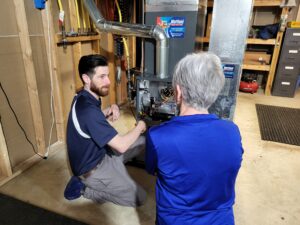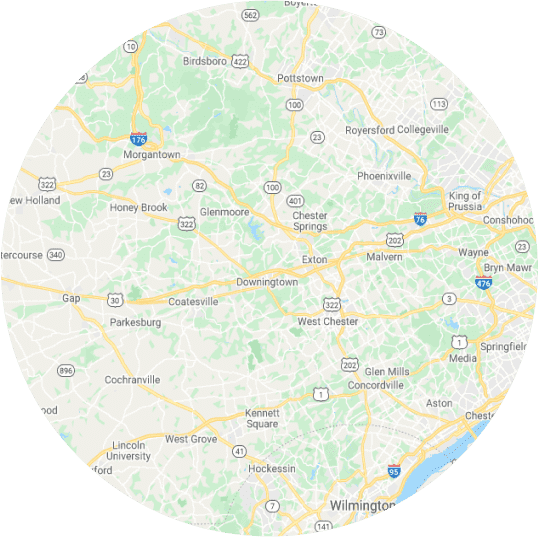How Much Does It Cost to Replace a Furnace in 2024?

|
Getting your Trinity Audio player ready...
|
Read Time: 8 Mins. | Last Revised: April 18, 2024
Understanding the 7 factors that influence how much a furnace costs to replace can help you evaluate which heating system is best for you and your home.
As we trek through those frigid mid-winter days, there’s nothing like a warm and comfortable home to come back to. For many of us, furnaces are the reliable backbone of our home heating systems that make this possible.
When it comes time to replace your furnace, knowing the factors that impact how much it will cost to install can help you clarify and rank your list of heating priorities.
The HVAC professionals here at Mattioni have helped countless homeowners understand all their furnace options and evaluate which systems are a good fit for them.
In this article, we’re going to focus on all the factors that determine how much a furnace costs to install.
We’re going to provide as much pricing transparency and clarity as possible because we believe that understanding what goes into installation pricing can help you make the best decision for you and your home.
That’s why we cracked open our price book and identified the following specific factors as the most influential in determining the price of installing a furnace:
- System Type & Equipment Matching
- Heating Capacity Needs
- Energy Efficiency of the System
- The Complexity of Installation and Ductwork Modifications Needed
- Accessories & Additional Systems
- Geography
- Quality of The Installation Company
Lining up these pricing factors with your heating priorities allows you to narrow down your search to a handful of furnaces that meet your goals and fit your budget. Let’s start by exploring the different types of furnaces out there.
1. System Type & Equipment Matching
Furnaces have different capabilities to throttle their temperature output (measured in British Thermal Units), which results in three broad classifications of system types:
- Single-stage furnaces operate at either 100% capacity or not at all.
- Two-stage furnaces have an added stage at roughly 65% capacity.
- Variable-speed furnaces can run at virtually any capacity.
Performance and energy efficiency typically increase as you go from single-stage to two-stage to variable-speed, so this decision will impact your comfort and monthly utility costs.
For a more detailed explanation of the technological differences between these systems, check out our article about the pros and cons of these types of furnaces.
In the Greater Philadelphia Region, many homes are set up with a cooling system that borrows the blower motor from your furnace to circulate the airflow throughout your house.
The blower motor itself usually mirrors the furnace’s heating output throttling capability to run at different speeds.
Because of this overlap in components, you’ll also have to be mindful of what type of cooling system you have when replacing your furnace. This is where things get a little tricky: equipment matching.
- Single-stage air conditioners are compatible with virtually any type of furnace.
- Two-stage air conditioners require a two-stage or variable-speed furnace.
- Variable-speed air conditioners are only compatible with variable-speed furnaces.
Since you’ll have to consider both systems during your replacement search, depending on your priorities, replacing both your heating and cooling systems at the same time might make sense.
If this seems confusing or overwhelming, don’t worry. Our HVAC professionals are here to answer all of your equipment matching questions.
Here’s a birds-eye view of all the possible price ranges for each different type of system:
- Single-stage furnaces typically range between $5,500 and $7,500
- Two-stage furnaces typically range between $8,000 and $12,000
- Variable-speed furnaces typically range between $13,000 and $14,000
One factor at play in where your total installation cost will fall within these ranges is the fuel source of the system.
Your furnace fuel options are oil, propane, and natural gas. Natural gas and propane furnaces are similar enough to consider the price difference between the two to be negligible. However, keep in mind that natural gas requires a public access hookup, which depends on where you live.
Propane and natural gas furnaces tend to be anywhere from $500 to $1,000 less expensive to install than an oil furnace.
Our next two factors, heating capacity and energy efficiency, also play vital roles in how your installation costs shape up.
2. Heating Capacity Needs
Heating capacity is measured in BTUs and refers to the amount of hot air produced by a furnace and delivered into your home. We sometimes call the heating capacity the “size” of the system.
We were able to find that, within the price ranges we just looked at, heating capacity is near-directly related to the cost of the system: for each additional increment of 20,000 BTUs, you can expect to pay around $500 more to install the system.
While your home’s square footage is a big factor in finding an appropriately sized furnace, there are several others at play:
- The insulation rating of your home
- The total number and efficiency of your windows and doors
- The number of people living in your home
- The direction that your home is facing
- The appliances in your home
- The color of your roof and exterior
- The interior layout of your home
As you can see, every home has a unique heating capacity need.
The size of your existing ductwork also plays a very important role in determining the appropriate size furnace for your home.
Ductwork that’s too narrow will not be able to facilitate the airflow of a furnace that might otherwise fit your home.
If your ductwork is too wide it’ll need an oversized furnace that’ll hinder efficiency and the comfortability of your home.
Don’t hesitate to talk with your HVAC professional about your existing ductwork and how it impacts your new system options. Modifications to your ductwork are sometimes the best bet for solving this.
Matching your home with an appropriately sized furnace will help with your home’s comfort and reduce energy costs, while also promoting the health and longevity of the system.
3. Energy Efficiency of the System (AFUE Rating)
Many homeowners prioritize the energy efficiency of their furnace, as it plays a big role in determining monthly utility bills.
Your guide with this is a standard metric called the Annual Fuel Utilization Efficiency, or AFUE which evaluates what percentage of fuel is converted into heat.
While the differences between single-stage, two-stage, and variable-speed furnaces indicate how efficient a system is, the AFUE rating gives the most precise efficiency analysis.
The most notable segmentation in furnace efficiencies is between what are commonly called 80% AFUE and 90% AFUE furnaces.
You can think of these percentages less as a score or rating, and more as a measurement of how many cents of heat the system produces per dollar of fuel.
Unique features like a second heat exchanger and condensation drain play a role in increasing furnace efficiencies into the 90% range and beyond. Today, the most efficient furnaces available are 98% AFUE.
While a more energy-efficient furnace will save you money on monthly utility bills, in most cases, the higher a system’s AFUE rating, the higher the upfront installation price will be.
4. The Complexity of Installation & Ductwork Modifications Needed
Most installations are straightforward, however there’s the potential for additional costs tied to the increased complexity of installing your new furnace.
Things like additional crew members, materials, modifications, accessibility, and added time are all factors that can increase the price of installation.
Accessibility of the Installation, Modifications & Additional Materials Needed
Furnace installations sometimes require additional work such as:
- Removing infrastructure like crown molding to create enough access to the installation site.
- Disassembling the old and/or new equipment to allow it to be removed or brought into the installation site.
- Cutting holes through drywall or the exterior of your home to run lines or wiring.
- Major duct modifications to physically fit the system or to handle the proper amount of airflow needed.
- Crawl space installations require installers to work while laying down.
Your new furnace may require new wiring or ductwork in order for it to be installed properly.
The three factors impacting just how much additional materials will raise the total installation cost are the type of material, the distance that needs to be spanned, and the difficulty of accessing that distance.
- Wiring: Wiring may also need to span up to 75 feet or more.
- Ductwork: Modifications to the ductwork closest to your furnace may be needed, and in some cases a plenum or return drop may need to be added for the system to be installed properly.
Making the necessary considerations to provide a quality installation can increase the price, however doing so will make sure that your system is set up for success and longevity.
Attic Installations
If your furnace is housed in your attic, some potential factors could impact the logistics of the job:
- Ease of access: Lifting the system up a ladder and fitting it through a narrow opening.
- Workability: Walking on joists if there is no flooring can add to the complexity of the job.
- Temperature: Summer installations require two-man crews to alternate working due to temperatures exceeding 110°F.
5. Accessories & Additional Systems
HVAC accessories like indoor air quality products and smart thermostats can enhance your home’s comfort and the accessibility of your heating system. These additional investments add to the total cost of your furnace installation.
Here are the average costs to install additional products and systems into your home:
Whole-House Humidifiers cost between $900 and $3,500 to install, depending on the size of your home.
Whole-House Dehumidifiers cost between $2,500 and $4,500 to install, depending on the size of your home, the amount of humidity that needs to be removed, and if the system will be ducted in, if it’s stand-alone or zoned for both.
Whole-House Air Scrubbers cost around $1,600 to install. If your home is large enough to call for two AC systems, we recommend getting two air scrubbers as well.
Whole-House Air Purifiers cost between $600 and $3,000 to install, depending on the type of air purifier and size of the system.
Energy Recovery Ventilation Systems (ERVs), also known as air intake systems, cost between $3,000 and $6,000 to install.
Smart Thermostats are sometimes required for variable-speed furnaces and variable-speed air conditioners. If you don’t have one already that is compatible with your system, they cost between $700 and $1,200 to install.
6. Geography
Like many other goods and services, your geographic location will also influence the price of installing a new furnace.
For instance, a furnace installation in a large city like New York will be more expensive than in a small town. The socio-economic status of where you live plays a part in this as well, however these price differences aren’t easily measured.
Although this factor is out of our control, staying aware of it will give you a better idea of how much your installation should cost, and if you’re getting a good quote or not.
7. Quality of the Installation Company
Not all HVAC installation companies are created equal. The quality of the company providing your installation services, and how they train their installers, is going to affect the total cost of installing your new furnace.
It’s not uncommon for a less professional company that overlooks the details of a quality installation to offer lower prices. If you get an appealing quote from a service provider who lacks testimonials or pictures of previous work, it might be a red flag that you’re talking to a corner-cutter installer.
Poor installations often follow cheap prices, which have several consequences on your new system’s performance, efficiency, and longevity.
Conversely, an HVAC installation company that provides trained, licensed, and experienced installers will deliver a quality installation that may come at a higher price, but will set your new system up for optimal performance, efficiency, and longevity.
Considering how future repair costs and efficiency levels impact the long-term costs tied to your furnace helps to put the quality of installation into context.
Making Your Furnace Replacement Decision
As you can see, there are a lot of variables in play that influence the final price of a new furnace, and some of these factors are outside of your control entirely. Suffice it to say, no two installations are identical.
If you haven’t already, here is a sound approach to your furnace replacement search.
- Rank your home heating priorities.
- Compare your priorities to the information covered in this article.
- Speak with an HVAC professional to narrow down your search to a few options.
Following these steps in order will help you start to sift through all the furnace options available and narrow down your search to a small list of options suited for your home.
When it comes time to talk with an HVAC professional, be sure to ask all of your questions as understanding your options is the best way to make a sound decision for the future of your home.
Our HVAC professionals are ready to guide you through this important process. To speak with the Mattioni team about furnace pricing, call us at 610-400-8510 or schedule an appointment online today.






